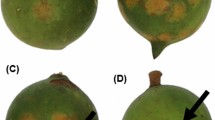Summary
Breeding for disease resistance in peppers (Capsicum spp.) to the bacterial spot pathogen (Xanthomonas campestris pv. vesicatoria (Doidge) Dye) has been based on either qualitative or quantitative evaluation methods. Quantitative evaluation of components of resistance, lesion number and lesion diameter, has been useful for determining quantitative resistance, but few breeders have applied these methods in routine selection programs. This study was aimed at determining the heritability and gain from selection for resistance to the bacterial spot pathogen based on three components of resistance. Random selections from a diverse intermated population of Capsicum annuum L. were self-pollinated for two generations to create S1 and S2 families. Thirty S1 families, corresponding S2 families and four homozygous check lines were evaluated. At forty-two days after seeding, two different leaves of each plant were inoculated by leaf infiltration with low concentrations (5×103 colony forming units) of Group 2 (XCV PT, race 1) and 4 (XCV P, race 1) of the bacterium, respectively. After 15 days, lesion number cm-2 and lesion diameter were measured. Total lesion area was calculated. Narrow-sense heritabilities for lesion number, lesion diameter, and total lesion area were 0, 43, and 31%, respectively, with Group 2, and 26, 43, and 33%, respectively, with Group 4. Actual S2 gain from 20% selection pressure in the S1 was approximately 50%, when selection towards resistance was based on total lesion area.
Similar content being viewed by others
References
Bonas, U., R.E., Stall & B., Staskawicz, 1989. Genetic and structural characterization of the avirulence gene avrBs3 from Xanthomonas campestris pv. vesicatoria. Mol. Gen. Genet. 218: 127–136.
Bongiolo Neto, A.B., F.J.B., Reifschneider & A., Takatsu, 1986a. Fontes de resistência a Xanthomonas campestris pv. vesicatoria em Capsicum. Hort. bras. 4(1): 21–25.
Bongiolo Neto, A.B., F.J.B., Reifschneider & A., Takatsu, 1986b. Levantamento de grupos de Xanthomonas campestris pv. vesicatoria no Brasil. Fitopatol. bras. 11: 881–889.
Falconer, D.S., 1981. Introduction to quantitative genetics. 2nd ed. Longman Inc., New York.
Frey, K.J. & T., Horner, 1955. Comparison of actual and predicted gains in barley selection experiments. Agron J. 47: 186–188.
Hallauer, A.R. & J.B. Miranda, Fo., 1981. Quantitative genetics in maize breeding. Iowa State University Press, Ames, IA.
Hibberd, A.M., M.J., Bassett & R.E., Stall, 1987a. Allelism tests of three dominant genes for hypersensitive resistance to bacterial spot of pepper. Phytopathology 77: 1304–1307.
Hibberd, A.M. & D., Gillespie, 1982. Heritability of field resistance to bacterial leaf spot disease in pepper (Capsicum annuumL.). Scientia Hortic. 17: 301–309.
Hibberd, A.M., R.E., Stall & M.J., Bassett, 1987b. Different phenotypes associated with incompatible races and resistance genes in bacterial spot disease of pepper. Plant Disease 71: 1075–1078.
Hibberd, A.M., R.E., Stall & M.J., Bassett, 1988. Quantitatively assessed resistance to bacterial leaf spot in pepper that is simply inherited. Phytopathology 78: 607–612.
Kado, C.I. & M.G., Heskett, 1970. Selective media for isolation of Agrobacterium, Corynebacterium, Erwinia, Pseudomonas and Xanthomonas. Phytopathology 60: 969–976.
Kearney, B. & B.J., Staskawicz, 1987. Molecular analysis of spontaneous race change in Xanthomonas campestris pv. vesicatoria. p. 155–161. In: D.J., Nevins & R.A., Jones (Eds). Tomato Biotechnology. Alan R. Liss. Inc., New York.
Klement, Z., Farkas, G.L. & L., Lovrekovich, 1964. Hypersensitive reaction induced by phytopathogenic bacteria in the tobacco leaf. Phytopathology 54: 474–477.
Minsavage, G.V., D., Dahlbeck, M.C., Whalen, U., Bonas, B.J., Staskawicz & R.E., Stall, 1990. Gene for gene relationships specifying disease resistance in Xanthomonas campestris pv. vesicatoria pepper interactions. Molecular Plant-Microbe Interactions 3(1): 41–47.
Poulos,J.M. 1990. Inheritance of quantitative components of group nonspecific resistance to Xanthomonas campestris pv. vesicatoria (Doidge) Dye and S2 recurrent selection for multiple disease resistance in Capsicum annuum L. Ph. D. diss. Cornell University, Ithaca, N.Y. 154 p.
Reifschneider, F.J.B., A., Bongiolo & A., Takatsu, 1985. Reappraisal of Xanthomonas campestris pv. vesicatoria strains — their terminology and distribution. Fitopatol. bras. 10(2): 201–204.
Ribeiro, R.L.D., O., Kimura, F., Akiba, O.C., de, Almeida & S., Sudo, 1982. Pepper breeding for resistance to Xanthomonas campestris pathovar vesicatoria. Arq. Univ. Fed. Rur. Rio de J. 5(2): 129–139.
Ronald, P.C. & B.J., Staskawicz, 1988. The avirulence gene avrBs1 from Xanthomonas campestris pv. vesicatoria encodes a 50-kD protein. Molecular Plant-Microbe Interactions 1(5): 191–198.
Smith, J.B. & M.L., Kinman, 1965. The use of parent-offspring regression as an estimator of heritability. Crop Sci. 5: 595–596.
Stall, R.E., 1981. Selection for component of horizontal resistance to bacterial spot of pepper. p. 511–517. In: J.C., Lozano (Ed). Proc. of the Fifth Intern. Conf. on Plant Pathogenic Bacteria. CIAT, Cali, Columbia, 640 p.
Swanson, J., B., Kearney, D., Dahlbeck & B.J., Staskawicz, 1988. Cloned avirulence gene of Xanthomonas campestris pv. vesicatoria complements spontaneous race-change mutants. Molecular Plant-Microbe Interactions 1(1): 5–9.
Takatsu, A. 1980. Preservação das bactérias fitopatogênicas pelo método de dessecação. Fitopatol. Bras. 5(3): 461.
Williams, P.H. 1975. Genetics of resistance in plants. Genetics 79: 409–419.
Author information
Authors and Affiliations
Rights and permissions
About this article
Cite this article
Poulos, J.M., Reifschneider, F.J.B. & Coffman, W.R. Heritability and gain from selection for quantitative resistance to Xanthomonas campestris pv. vesicatoria in Capsicum annuum L.. Euphytica 56, 161–167 (1991). https://doi.org/10.1007/BF00042060
Received:
Accepted:
Issue Date:
DOI: https://doi.org/10.1007/BF00042060




